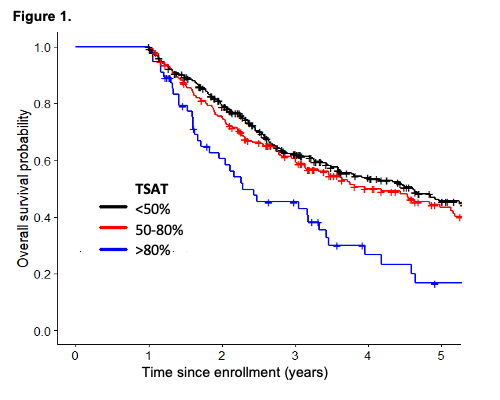
Contributions
Abstract: EP931
Type: E-Poster Presentation
Session title: Myelodysplastic syndromes - Clinical
Background
Iron overload (IO) reflected by increased ferritin level is associated with increased mortality in patients with myelodysplastic syndromes (MDS). However, ferritin is an imperfect metric of true IO. Elevated levels of oxidatively damaging non-transferrin bound iron and labile plasma iron correlate with transferrin saturation (TSAT) >70% and >80% respectively, but are not readily measurable.
Aims
We aimed to describe trends in TSAT in transfusion dependent MDS and to determine its relation to ferritin level and clinical outcomes.
Methods
Patients enrolled in the Canadian MDS registry from January 2008 to June 2019 were evaluated. Mean values of ferritin and TSAT were calculated at six-month intervals, and general linear mixed model analysis was used. Transfusion density was calculated at landmark year 1 and defined as the median number of units transfused per month since the onset of transfusion dependence (TD), with TD-low and TD-high defined as above or below the median. Survival was evaluated by TSAT category (<50%, 50-80%, >80%), and ferritin (≤500ug/L, 501-800ug/L, >800ug/L) using the mean values from enrolment onwards.
Results
718 patients were included. Median age was 74 years. 12%, 31%, 29%, 15% and 13% were IPSS-R very low, low, intermediate, high and very high, respectively. With a median follow up of 2.1 years, actuarial overall survival (OS) was 2.4 years. 17% developed AML and 61% have died. AML, MDS progression, infection, cardiac events, and bleeding accounted for 26%, 20%, 19%, 9.6% and 6.34% of known causes of death, respectively. Mean TSAT increased with incremental ferritin categories, however TSAT and ferritin were only moderately correlated over time (r=0.63, p < 0.0001). Among all patients, ferritin increased from enrolment up to 42 months (p<0.0001), while TSAT remained stable over time (p=0.094). In TD patients, there was a significant increase in TSAT over time (p=0.0063). Median transfusion density was 2.7 units/month by landmark year 1. Higher TSAT and ferritin were both associated with inferior 5-year OS, PFS and LFS (Figure 1). In patients with ferritin >1000ng/mL, stratifying by TSAT category showed a trend toward OS. Higher transfusion density was also associated with inferior 5-year OS. In TD patients, TSAT category predicted cardiac death-free survival (DFS) (p= 0.0011), while ferritin category predicted infectious death. In univariate analysis, age, IPSS-R, blast percentage, ECOG, frailty score, Charlson Comorbidity Index, iron chelation (Y/N), transfusion density, TSAT category and ferritin category were significantly associated with inferior OS. In multivariate analysis, TSAT >80% (HR 1.58 95%CI 1.13-2.21) and high-TD (HR 1.90 vs. low-TD 95%CI 1.39-2.60) remained significant for OS (R2 30.35%).

Conclusion
Among a cohort of predominantly low-intermediate risk MDS patients, TSAT correlated moderately with serum ferritin. TSAT >80%, ferritin >800 ug/mL and high transfusion density were each associated with inferior survival. TSAT may be an indicator of the degree of oxidative stress present, and is readily measurable in a clinical setting. The relationship between elevated TSAT and reduced cardiac DFS warrants further study.
Keyword(s): Ferritin, Iron overload, MDS, Transferrin
Abstract: EP931
Type: E-Poster Presentation
Session title: Myelodysplastic syndromes - Clinical
Background
Iron overload (IO) reflected by increased ferritin level is associated with increased mortality in patients with myelodysplastic syndromes (MDS). However, ferritin is an imperfect metric of true IO. Elevated levels of oxidatively damaging non-transferrin bound iron and labile plasma iron correlate with transferrin saturation (TSAT) >70% and >80% respectively, but are not readily measurable.
Aims
We aimed to describe trends in TSAT in transfusion dependent MDS and to determine its relation to ferritin level and clinical outcomes.
Methods
Patients enrolled in the Canadian MDS registry from January 2008 to June 2019 were evaluated. Mean values of ferritin and TSAT were calculated at six-month intervals, and general linear mixed model analysis was used. Transfusion density was calculated at landmark year 1 and defined as the median number of units transfused per month since the onset of transfusion dependence (TD), with TD-low and TD-high defined as above or below the median. Survival was evaluated by TSAT category (<50%, 50-80%, >80%), and ferritin (≤500ug/L, 501-800ug/L, >800ug/L) using the mean values from enrolment onwards.
Results
718 patients were included. Median age was 74 years. 12%, 31%, 29%, 15% and 13% were IPSS-R very low, low, intermediate, high and very high, respectively. With a median follow up of 2.1 years, actuarial overall survival (OS) was 2.4 years. 17% developed AML and 61% have died. AML, MDS progression, infection, cardiac events, and bleeding accounted for 26%, 20%, 19%, 9.6% and 6.34% of known causes of death, respectively. Mean TSAT increased with incremental ferritin categories, however TSAT and ferritin were only moderately correlated over time (r=0.63, p < 0.0001). Among all patients, ferritin increased from enrolment up to 42 months (p<0.0001), while TSAT remained stable over time (p=0.094). In TD patients, there was a significant increase in TSAT over time (p=0.0063). Median transfusion density was 2.7 units/month by landmark year 1. Higher TSAT and ferritin were both associated with inferior 5-year OS, PFS and LFS (Figure 1). In patients with ferritin >1000ng/mL, stratifying by TSAT category showed a trend toward OS. Higher transfusion density was also associated with inferior 5-year OS. In TD patients, TSAT category predicted cardiac death-free survival (DFS) (p= 0.0011), while ferritin category predicted infectious death. In univariate analysis, age, IPSS-R, blast percentage, ECOG, frailty score, Charlson Comorbidity Index, iron chelation (Y/N), transfusion density, TSAT category and ferritin category were significantly associated with inferior OS. In multivariate analysis, TSAT >80% (HR 1.58 95%CI 1.13-2.21) and high-TD (HR 1.90 vs. low-TD 95%CI 1.39-2.60) remained significant for OS (R2 30.35%).

Conclusion
Among a cohort of predominantly low-intermediate risk MDS patients, TSAT correlated moderately with serum ferritin. TSAT >80%, ferritin >800 ug/mL and high transfusion density were each associated with inferior survival. TSAT may be an indicator of the degree of oxidative stress present, and is readily measurable in a clinical setting. The relationship between elevated TSAT and reduced cardiac DFS warrants further study.
Keyword(s): Ferritin, Iron overload, MDS, Transferrin


